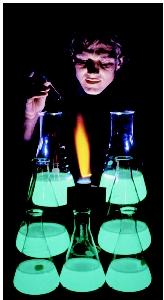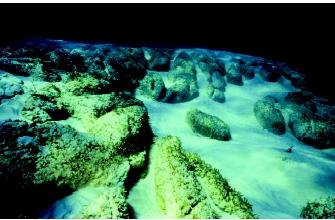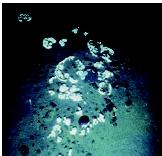Microbes in the Ocean
The oceans teem with microorganisms such as bacteria, viruses, and protists. Many of these microbes fundamentally influence the ocean's ability to sustain life on Earth. Some microbes living and transported in ocean water, however, threaten human health.

Occurrence and Role in the Ocean
In the open ocean, far from the influences of coastal human habitation, sea water still contains huge numbers of microbes. Coastal areas can contain even greater concentrations. Vast numbers of bacteria and plankton occur both at the surface and in deep ocean waters. Viruses are entities that require bacteria or other cells in order to make copies of their genetic material and to construct new casings that house the genetic material. Scientific studies have shown that 10 to 100 million viruses can be present in a teaspoonful of sea water.
Plankton.
More plankton exist in sea water than any other organism. Microscopic forms include protists and bacteria. Phytoplankton are photosynthetic organisms, including algae. By harvesting the energy of the Sun and converting it to their tissues, phytoplankton form the basis of the food chain in the ocean. All ocean organisms depend on phytoplankton either directly or indirectly. Eventually, humans consume ocean creatures such as fish. Even human life, therefore, is tied to the presence of phytoplankton.
Microbes such as plankton also have other benefits. In the ocean, they help make some nutrients available to other living marine creatures. Elemental iron, for example, is important for living creatures but is scarce in the ocean. Sunlight can change iron to a form that can be taken up by plankton and other microbes. The microorganisms are used as food by other organisms, such as fish and ocean mammals, making the iron available to other creatures in the food chain.
Viruses.
Marine viruses can be both detrimental and beneficial to the ocean's health. Some viruses attack and kill plankton, eliminating the base of the ocean food chain in a particular area. At the same time, this dead plankton can become a source of carbon that is not otherwise readily available to other sea life. Scientists estimate that up to 25 percent of all living carbon in the oceans is made available through the action of viruses. When these aspects remain in proper balance, the ocean functions normally.
Bacteria.
Bacteria are single-celled organisms without cell nuclei. They are found in all portions of the water column, the sediment surface, and the sediments themselves. Some are aerobic (requiring oxygen), whereas others are anaerobic (not requiring oxygen). Most bacteria are free-living, but some live as partners (symbionts) within other organisms. For instance, many deep-sea fish harbor symbiotic bacteria that emit light, which the fish use to signal other members of their species. The bacteria's ability to emit light is called bioluminescence. Bioluminescence causes water to glow, a phenomenon most noticeable at the surface but present at all depths.
Cyanobacteria, a type of bacteria, played an important role in the history of Earth and in ocean processes, including the development of stromatolites (see photograph on page 80). Living in colonies, the cyanobacteria produced oxygen during the process of photosynthesis, which generated the oxygen in the Earth's atmosphere that many living beings require today. Although cyanobacteria also are called "blue-green algae," it is important to remember that cyanobacteria are relatives of bacteria and not algae. They are, however, related to the chloroplasts within algae; the chloroplasts used by some plants to produce food are actually cyanobacteria living within plants' cell walls.

Some marine bacteria can interact with diatoms, another type of marine microbe, in such a way that influences the cycling of silicon in the ocean. Diatoms, a group of unicellular algae, are characterized by their highly ornate two-part shell-like structures made from silica.
One species of bacteria, Thiomargarita namibiensis, plays a critical role in hydrogen sulfide eruptions from diatomaceous sediments off Africa's Namibia coast. Known as the "sulfur pearl of Namibia," this anaerobic species digests organic matter under low-oxygen (or no-oxygen) conditions that are caused by high rates of phytoplankton growth in the Benguela upwelling zone, and the subsequent decay of large masses of dead phytoplankton that have fallen to the seafloor.
The anaerobic activity leads to the formation of hydrogen sulfide gas (H 2 S) in the sediment. Over time, the gases build up and are periodically released into the water column in a "sulfide eruption." At the water surface, the H 2 S oxidizes to microgranules of sulfur, discoloring it a milky green. These surface features can be observed by satellites (see photograph on page 81).
Recent Discoveries: Archaea.
Knowledge of the diversity of microbial life in the oceans continues to grow. Until the 1990s, knowledge of microbial populations was determined using assays that relied on the growth of the microbe. Now, detection and identification of microbes are possible by the examination of their genetic material. These molecular assay techniques have revealed much larger numbers and types of microbes in the ocean than scientists previously suspected.
The bacteria-like microbes known as Archaea represent one example of research surprising to marine microbiologists. Archaea are one of the major domains of life on Earth. Since their discovery in 1970, these microorganisms have been found in many extreme environments on Earth, including hydrothermal vents on the ocean floor. Recently, scientists determined that Archaea also exist in the open sea. Moreover, these microbes may comprise up to half the mass of life in the oceans, and so must play an important role in the processes that occur in the oceans.

Since 2001, the examination of sediment from the sea bottom has revealed the presence of another type of Archaea that exist by using methane, an important gas that is contributing to the warming of the Earth's atmosphere. In addition, bacteria that exist by using the rocks of the sea bottom as food have been discovered. The release of material from the sediment by the action of the rock-using bacteria may influence the chemistry of the oceans.
Animal and Human Health Impacts
Some ocean microorganisms can cause unhealthy effects in both land and sea animals. This is particularly true in coastal regions, where the influence of humans is more evident. For example, runoff or the deliberate release of

Just as humans are susceptible to microbial infections, so too can marine animals (e.g., mammals) develop infections. It is believed that infections are to blame for at least some cases of marine mammal "beachings," in which whales or dolphins become stranded on the shore. It is thought that human pollution may exacerbate this problem by increasing the likelihood of infection and decreasing the quality of the water.
Another potentially harmful microbe found naturally in the ocean is a protist called a dinoflagellate. At certain times and under certain conditions, some dinoflagellate species and other algal species can undergo population explosions called blooms, sometimes in response to human-caused pollution. These blooms often are called "red tides" because the algal pigments color the water. Further, some of the bloom-causing algae may produce natural poisons known as biotoxins. These biotoxins are transferred to ocean animals that feed on the toxin-containing algae, and also are released into the water as the dead algae decay. These biotoxins can bioaccumulate in the ocean food chain, sickening or killing higher-order animal consumers and tainting fisheries and shellfisheries used by humans.
Human Pathogens.
The ocean has long been used as a means of disposal of human wastes, and still is used this way in many areas of the world. The enormous size of the oceans historically and incorrectly was assumed able to dilute any noxious material to concentrations low enough to render them harmless. While small amounts of sewage can dissipate quickly, the routine dumping of large amounts of human waste has caused long-term harm to many shoreline ecosystems , and rendered many coastal waters unfit for recreational activities.
For example, high numbers of disease-causing viruses and a bacterial species called Escherichia coli can occur in coastal waters influenced by human wastes (e.g., sewage). If ingested, these microbes can cause intestinal upset and organ damage that varies from inconvenient to life-threatening. Furthermore, the viruses that cause hepatitis A, hepatitis E, and polio, along with protozoan pathogens that cause giardiasis and cryptosporidiosis, are sometimes found in coastal waters and estuaries .
Another example related to improperly treated or untreated sewage is Vibrio cholerae, the bacterium that causes the intestinal infection cholera. Huge outbreaks of cholera have occurred throughout recorded history. In recent years, severe outbreaks of cholera occurred in Bangladesh and in Peru. Some evidence suggests that the cyclical temperature increase associated with El Niño currents increases the likelihood of such outbreaks, by increasing the ability of the bacterium to reproduce in polluted waters.
Vibrio cholerae and other infectious bacteria and viruses also are commonly present in high numbers in the ballast water of ocean-going ships, and can be widely spread by these ships. Ballast water is water that is pumped into the hull of a ship in order to stabilize it against the rough conditions of an ocean voyage. When the ship reaches port, millions of liters of ballast water are pumped out into the harbor, releasing the microbes into the new environment. Currents can act as highways for microbes, carrying them along in the water flow. Viruses, which can live in the ocean for days or weeks, can be transported great distances via ocean currents.
SEE ALSO Algal Blooms, Harmful ; Algal Blooms in the Ocean ; Carbon Dioxide in the Ocean and Atmosphere ; El NiÑo and La NiÑA ; Food from the Sea ; Life in Extreme Water Environments ; Human Health and the Ocean ; Human Health and Water ; Ocean Biogeochemistry ; Ocean Currents ; Plankton ; Pollution by Invasive Species ; Pollution of the Ocean by Sewage, Nutrients, AND Chemicals .
Brian D. Hoyle
and Richard Robinson
Bibliography
Fuhrman, Jed A. "Marine Viruses and Their Biogeochemical and Ecological Effects." Nature 399 (1999):541–548.
Karner, Markus B., Edward F. DeLong, and David M. Karl. "Archaeal Dominance in the Mesopelagic Zone of the Pacific Ocean." Nature 409 (2001):507–509.
Orphan, Victoria J. et al. "Methane-Consuming Archaea Revealed by Directly Coupled Isotopic and Phylogenetic Analysis." Science 293 (2001):484–487.
Ruiz, Gregory M. et al. "Global Spread of Microorganisms by Ships." Nature 408 (2000):49–50.
Suttle, Curtis A. "The Significance of Viruses to Mortality in Aquatic Microbial Communities." Microbial Ecology 28 (1994):237–243.
Comment about this article, ask questions, or add new information about this topic: